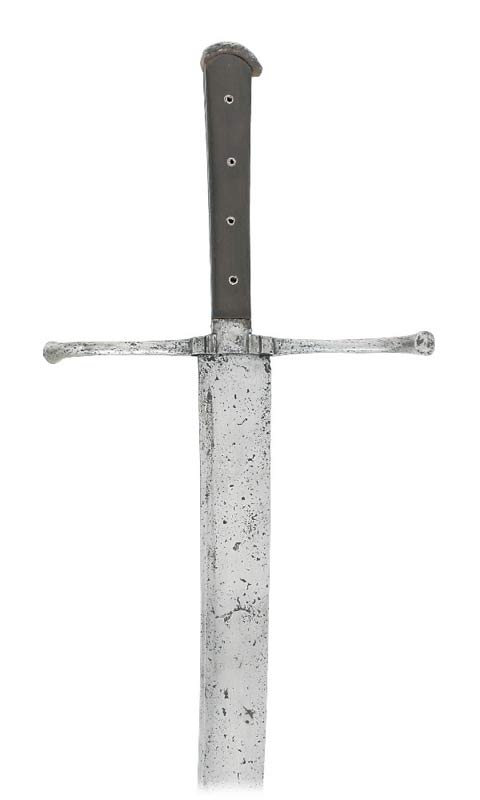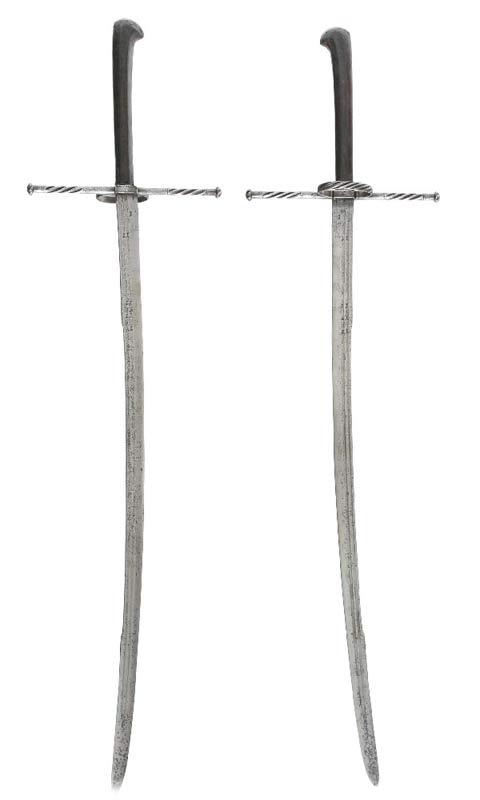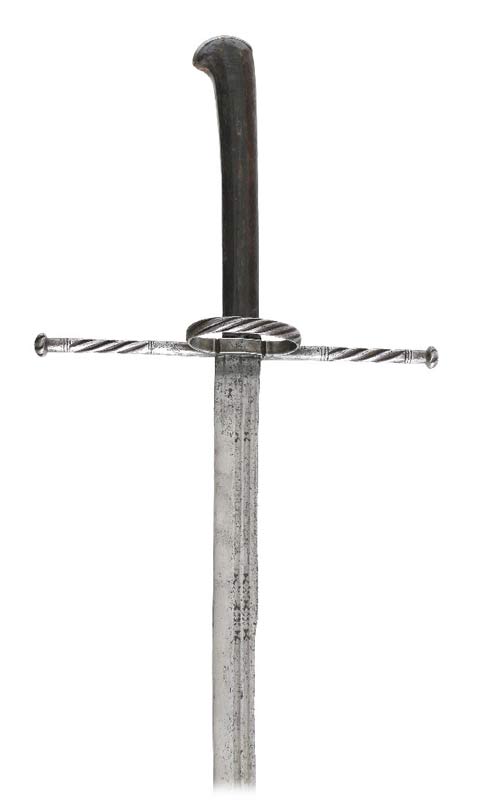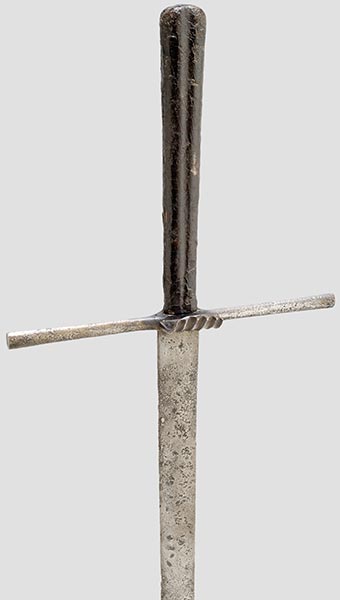
| myArmoury.com is now completely member-supported. Please contribute to our efforts with a donation. Your donations will go towards updating our site, modernizing it, and keeping it viable long-term.
Last 10 Donors: Graham Shearlaw, Anonymous, Daniel Sullivan, Chad Arnow, Jonathan Dean, M. Oroszlany, Sam Arwas, Barry C. Hutchins, Dan Kary, Oskar Gessler (View All Donors) |
| Author |
Message |
Nathan Robinson
myArmoury Admin


|
|
    |
 |
|
Danny Grigg
|
 Posted: Fri 24 Aug, 2007 10:56 pm Post subject: Posted: Fri 24 Aug, 2007 10:56 pm Post subject: |
 |
|
| Nathan Robinson wrote: | | Here's another. Just a phone. No details, though. |
Nathan, I have the following photo, not sure where I got it from though.
Danny
 Attachment: 116.15 KB Attachment: 116.15 KB
[ Download ]
|
|
  |
 |
|
Danny Grigg
|
|
  |
 |
|
Mick Czerep
Location: Poland Joined: 30 May 2007
Posts: 59
|
 Posted: Sat 25 Aug, 2007 4:15 am Post subject: Posted: Sat 25 Aug, 2007 4:15 am Post subject: |
 |
|
Nathan:
My Messer was made by Jan Chodkiewicz, who has posted his work in the Makers forum (ballock dagger). He's obviously a Polish producer, lives in Gdansk.
Cheers
Mick
Sordes ocurrit
|
|
   |
 |
Nathan Robinson
myArmoury Admin


|
 Posted: Tue 11 Sep, 2007 5:00 pm Post subject: Posted: Tue 11 Sep, 2007 5:00 pm Post subject: |
 |
|
I have a couple more photos to share.
Hauschwert, Deutschland um 1530.
A Rare German Sword, circa 1530.
A slightly curved, single-edged blade with fullers on both sides and a double-edged point. Simple, 'S'-shaped and curved quillons. Wooden hilt plates and lunashaped pommel. Length 101 cm
 Attachment: 15 KB Attachment: 15 KB

Messer photo
full
 Attachment: 16.22 KB Attachment: 16.22 KB

Messer photo
hilt
.:. Visit my Collection Gallery :: View my Reading List :: View my Wish List :: See Pages I Like :: Find me on Facebook .:.
|
|
    |
 |
Nathan Robinson
myArmoury Admin


|
 Posted: Tue 11 Sep, 2007 5:03 pm Post subject: Posted: Tue 11 Sep, 2007 5:03 pm Post subject: |
 |
|
And a couple more.
Schwert zu Anderthalb Hand oder 'Langes Messer', Deutschland um 1550
A German Hand-and-a-Half Sword or 'Long Knife', circa 1550.
Slightly curved single-edged blade and double shallow grooves on either side. Twisted and straigt iron quillons and guard ring. Wooden shaft grip. Length 108 cm.
 Attachment: 13.54 KB Attachment: 13.54 KB

Messer photo
full
 Attachment: 14.28 KB Attachment: 14.28 KB

Messer photo
hilt
.:. Visit my Collection Gallery :: View my Reading List :: View my Wish List :: See Pages I Like :: Find me on Facebook .:.
|
|
    |
 |
Bill Grandy
myArmoury Team


|
 Posted: Tue 11 Sep, 2007 8:10 pm Post subject: Posted: Tue 11 Sep, 2007 8:10 pm Post subject: |
 |
|
Awesome, Nathan.
| Nathan Robinson wrote: | I have a couple more photos to share.
Hauschwert, Deutschland um 1530.
A Rare German Sword, circa 1530.
A slightly curved, single-edged blade with fullers on both sides and a double-edged point. Simple, 'S'-shaped and curved quillons. Wooden hilt plates and lunashaped pommel. Length 101 cm |
This appears to be the same one that Danny linked to above, but it's nice to have it within the thread anyway, in case that auction disappears.
The second one you posted is interesting to me. Lutel made one very similar to that. It's interesting because it doesn't have the characteristic rivets so typical in most messers. Cool stuff!
HistoricalHandcrafts.com
-Inspired by History, Crafted by Hand
"For practice is better than artfulness. Your exercise can do well without artfulness, but artfulness is not much good without the exercise.” -anonymous 15th century fencing master, MS 3227a
|
|
   |
 |
Nathan Robinson
myArmoury Admin


|
|
    |
 |
|
Caleb Hallgren
Location: DeKalb, IL Joined: 01 Aug 2004
Posts: 64
|
|
    |
 |
Jean Henri Chandler

|
 Posted: Wed 12 Sep, 2007 10:07 am Post subject: Posted: Wed 12 Sep, 2007 10:07 am Post subject: |
 |
|
Fascinating how some of the blades look like they have false edges and / or fullers or ridges down the center.
It's also interesting how these guys have shields, what kind of troop type do you call that? Am I right to assume they are landskenchts .. ? Never heard of messer and shield men in landsknecht companies before
Books and games on Medieval Europe Codex Integrum
Codex Guide to the Medieval Baltic Now available in print
|
|
  |
 |
|
Mike West
|
 Posted: Wed 12 Sep, 2007 5:39 pm Post subject: SIngle side ring/side bar? Posted: Wed 12 Sep, 2007 5:39 pm Post subject: SIngle side ring/side bar? |
 |
|
I've noticed that many messers have a single side ring, or downward curving bar. Why only one and, not two? It seems as if the purpose of the side ring would be to protect the hand, or help catch an opponents blade suring a defensive maneuver.
But only one side? Wouldn't two have been better?
|
|
  |
 |
Bill Grandy
myArmoury Team


|
 Posted: Wed 12 Sep, 2007 10:29 pm Post subject: Re: SIngle side ring/side bar? Posted: Wed 12 Sep, 2007 10:29 pm Post subject: Re: SIngle side ring/side bar? |
 |
|
| Mike West wrote: | I've noticed that many messers have a single side ring, or downward curving bar. Why only one and, not two? It seems as if the purpose of the side ring would be to protect the hand, or help catch an opponents blade suring a defensive maneuver.
But only one side? Wouldn't two have been better? |
While I doubt anyone truly knows, I suspect a couple of reasons:
-Less metal means a less expensive weapon
-Having one side "ringless" is more comfortable for wearing at the belt
Also, having done my fair share of fencing with these weapons, and similar weapons, the outside of the hand is much more vulnerable to attack than the other side, so while, yes, two rings is more protective, it isn't a significant difference.
HistoricalHandcrafts.com
-Inspired by History, Crafted by Hand
"For practice is better than artfulness. Your exercise can do well without artfulness, but artfulness is not much good without the exercise.” -anonymous 15th century fencing master, MS 3227a
|
|
   |
 |
|
Peter Grassmann
|
 Posted: Thu 13 Dec, 2007 3:32 pm Post subject: Posted: Thu 13 Dec, 2007 3:32 pm Post subject: |
 |
|
Hi all,
Sorry to reply to this old thread, but I think I can add something.
I have done much research on German "Messers" and "Bauernwehren" and I have also written a short article about this topic (only in German). I think you have to see many weapons, which are normally seen individually, in a larger context. There is a tendency towards single edged, riveted weapons since the 14th century that reaches its peak from the second half of the 15th to the early 16th century. The ancesters of all these riveted weapons seems to have been the riveted knives that come up in the 10th/11th century, but become popular in the 13th/14th century. From these knives, a certain kind of defensive weapon developed - the so-called "Bauernwehr". This weapon is hard to define; you have to get a lot of training to recognize them. Characteristics are a single edged blade, a total length above ~25 cms and a riveted tang. Those Bauernwehren could reach lengths up to 90 cms and more. From these weapons, a variety of other weapons spread across Europe - all having single edged blades, a riveted tang and being asymmetrical. The "Lange Messer" must be seen in this context. What distinguishes the Messer from the Bauernwehr is the fact that a Bauernwehr NEVER has a crossguard. They have constructions called "Knebel" oder "Nagel" in German, but no crossguard. In contrast, a "Messer" ALWAYS has some kind of crossguard.
Therefore this pictures shows no Messer, but a large weapon in the tradition of the "Bauernwehr":

Maybe I will translate my article and present it to you, if you are interested. Unfortunately, I can't name many (literary) sources, as most of it is based on many years of experience and looking at hundreds of originals. Literature doesn't deal with this particular devolpment much, and the Bauernwehren are almost never discussed.
Best regards,
Peter
|
|
  |
 |
Bill Grandy
myArmoury Team


|
 Posted: Thu 13 Dec, 2007 9:42 pm Post subject: Posted: Thu 13 Dec, 2007 9:42 pm Post subject: |
 |
|
| Peter Grassmann wrote: | | Maybe I will translate my article and present it to you, if you are interested. |
Hi Peter,
I know I, for one, would definately be interested!
HistoricalHandcrafts.com
-Inspired by History, Crafted by Hand
"For practice is better than artfulness. Your exercise can do well without artfulness, but artfulness is not much good without the exercise.” -anonymous 15th century fencing master, MS 3227a
|
|
   |
 |
Nathan Robinson
myArmoury Admin


|
 Posted: Fri 25 Jan, 2008 6:23 pm Post subject: Posted: Fri 25 Jan, 2008 6:23 pm Post subject: |
 |
|
Another example from Hermann Historica.
Interesting how straight the blade is. I'd like to know of its geometry.
circa 1520. A straight, single-edged blade with a smith mark stamped twice on one side. Straight quillons with oval cross-section. Shell-shaped guard plate. Grooved grip with leather cover. Length 102 cm.
Rare edged weapon of the early Landsknecht period.
 Attachment: 7.16 KB Attachment: 7.16 KB

Copyright Hermann Historica
 Attachment: 13.17 KB Attachment: 13.17 KB

Copyright Hermann Historica
.:. Visit my Collection Gallery :: View my Reading List :: View my Wish List :: See Pages I Like :: Find me on Facebook .:.
|
|
    |
 |
Patrik Erik Lars Lindblom

|
|
  |
 |
|
Jason Elrod
|
 Posted: Sun 10 Feb, 2008 3:56 pm Post subject: Posted: Sun 10 Feb, 2008 3:56 pm Post subject: |
 |
|
| Peter Grassmann wrote: |
Maybe I will translate my article and present it to you, if you are interested. Unfortunately, I can't name many (literary) sources, as most of it is based on many years of experience and looking at hundreds of originals. Literature doesn't deal with this particular devolpment much, and the Bauernwehren are almost never discussed.
Best regards,
Peter |
I would love to read this article too.
|
|
  |
 |
Bill Grandy
myArmoury Team


|
 Posted: Sun 10 Feb, 2008 4:01 pm Post subject: Posted: Sun 10 Feb, 2008 4:01 pm Post subject: |
 |
|
Nice find, Patrik! Those look very much like the messers in the Peter Falkner fechtbuch, in fact.
I'm glad this thread got bumped, actually. I've been studying more and more messerfechten, and its fast becoming one of my favorite weapon styles. It is a very beautiful art form for such a "common" weapon. 
HistoricalHandcrafts.com
-Inspired by History, Crafted by Hand
"For practice is better than artfulness. Your exercise can do well without artfulness, but artfulness is not much good without the exercise.” -anonymous 15th century fencing master, MS 3227a
|
|
   |
 |
Sean Flynt

|
|
   |
 |
|
Peter Grassmann
|
|
  |
 |
|
|
You cannot post new topics in this forum
You cannot reply to topics in this forum
You cannot edit your posts in this forum
You cannot delete your posts in this forum
You cannot vote in polls in this forum
You cannot attach files in this forum
You can download files in this forum
|
All contents © Copyright 2003-2025 myArmoury.com — All rights reserved
Discussion forums powered by phpBB © The phpBB Group
Switch to the Basic Low-bandwidth Version of the forum
|

